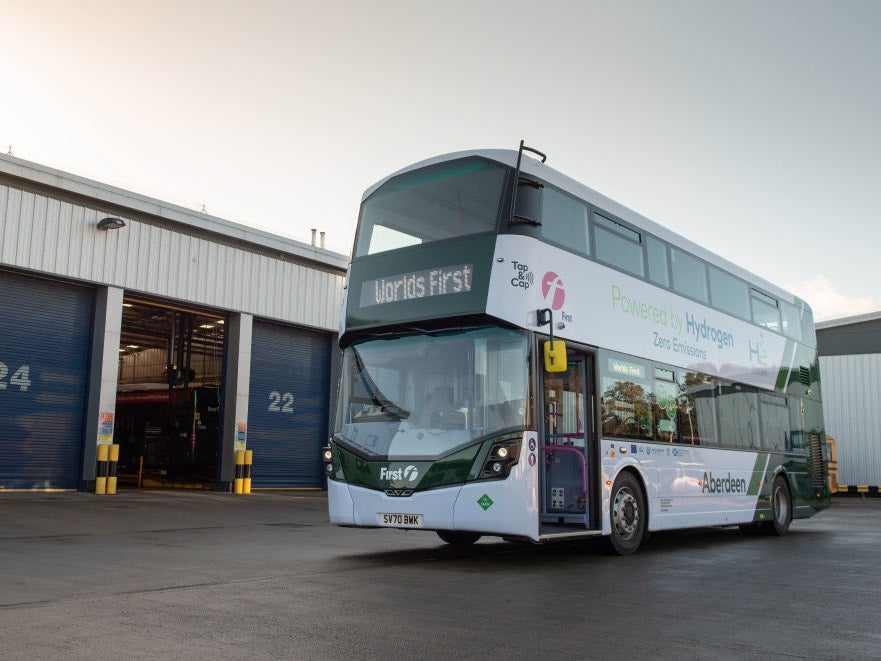
Interest in hydrogen fuel has intensified as countries urgently seek to achieve energy security following Russia’s invasion of Ukraine while meeting net-zero targets.
Due to the ongoing conflict, several nations have announced plans to end imports of Russian oil and gas as soon as possible – and there is a growing consensus that hydrogen is one of the most viable alternative fuels.
A key example of this drive toward hydrogen is that German officials recently visited Scotland to learn more about the country’s growing clean energy industry. Germany has been heavily dependent on Russian gas but is now taking a serious look at alternatives due to Russia’s actions in Ukraine.
The delegation was led by Stefan Kaufmann, a former German government minister who is now a government advisor for innovation and hydrogen. Kaufmann and another German government official toured various hydrogen facilities and green energy sites around Scotland. Upon completing his visit, Kaufmann said he was impressed by the Scottish government’s commitment to producing green hydrogen to create jobs and decarbonise the economy. Kaufmann also expressed a desire to develop a close partnership with Scotland in hydrogen supply and development.
Scotland’s long history in oil and gas offers extensive experience in industrial processes, with the necessary pipelines for gases and transferrable skills of workers for hydrogen. In addition, the nation has all the infrastructure, R&D capabilities, test centres and natural resources to be a genuine world leader in green hydrogen production.
“We see Scotland having a key role in the development of the hydrogen economy globally,” says Jamie Robinson, a hydrogen specialist in the low carbon transition team at Scottish Enterprise. “That is where we want to position it, and it is something we can actually achieve.”
Hydrogen production support to decarbonise transport
Perhaps the biggest misconception about hydrogen is to view it as a like-for-like replacement for oil and gas. In reality, hydrogen will likely become part of a broader energy mix and be used typically in heavy industries such as shipping and haulage, which are considered more challenging to decarbonise.

For many years, there was some debate about the most viable zero-carbon fuels. Hydrogen was doubted due to the costs and storage demands. Hydrogen requires high-pressure tanks if a gas, or temperatures of -253°C in liquid form.
Yet there is now a growing agreement around hydrogen due to several projects that have proven the benefits. These include a series of impressive small-scale demonstrations in Scotland that are now scaling up.
An example is that Scottish coach manufacturer Alexander Dennis produced a bus fleet powered by hydrogen. The first-ever double-decker bus that runs on this zero-carbon fuel is operating on routes in Aberdeen, and was manufactured by Northern Ireland-based Wright Bus.
There is also a growing belief that efficiencies will increase and costs will fall as the technology develops.
“Demand is obviously ramping up,” adds Robinson. “The amount of projects in the pipeline certainly is ramping up, but the technology needs to catch up. It exists, it is just a case of making it more commercial. A lot of that will come with scale. The main obstacle here is definitely still cost.
“All the major electrolyser manufacturers are looking to expand. They are looking at putting in new gigafactories and scaling up, so that will undoubtedly bring costs down.
“The rule of thumb just now for electrolysers is roughly a thousand dollars per kilowatt, but some are predicting that will come down to $300 or even $100 before the end of the decade. That is a huge decrease.”
To support hydrogen industry growth, the Scottish government is providing £100m over five years for projects and organisations developing specialist technologies.
Green hydrogen production in Scotland: carbon capture to wind energy
While hydrogen fuel itself produces zero emissions at the point of use, its traditional production has been carbon-intensive in what is known as grey hydrogen. Production typically compresses natural gas, splitting it into hydrogen and CO2. Hydrogen is then stored, but carbon is emitted as a waste product. This makes the process incompatible with net-zero targets.
Scotland will not support the production of grey hydrogen but will support blue hydrogen, which uses similar production processes yet captures and stores the CO2 waste product instead.
Green hydrogen is viewed as the most desirable form of the fuel, taking water and performing electrolysis with renewable energy to produce hydrogen and oxygen.
Furthermore, there is a desire to manufacture green hydrogen using excess wind energy generated in remote areas that cannot be used by the grid, known as stranded wind. When it comes to wind energy, Scotland is a global leader with considerable offshore resources.
In terms of generation capacity, Scotland currently has 10GW of offshore wind that is either on stream or in development. The next phase of development – Scotwind – will see Scotland generate an additional 25GW of offshore wind by the mid-2030s through a mix of floating and fixed installations, and there remains massive scale-up potential beyond that.
Currently, Scotland is producing relatively small amounts of green and blue hydrogen, but the plan is to reach a generation capacity of 5GW a year by 2030, amounting to an estimated 700,000–800,000 tonnes of the fuel.
Given the intensity of demand for hydrogen and the increased focus on development, Robinson suggests that the total generation capacity may even exceed 5GW before 2030, while Scotland’s target to produce 25GW from hydrogen by 2045 may be achieved sooner than expected.
“I have no doubt there will be a massive volume of hydrogen coming from Scotland; it is just really the timing of that,” adds Robinson. “There are very few other countries that can really even come close to those numbers we are talking about in terms of long-term hydrogen production potential.”
Scottish hydrogen companies
In Scotland, companies developing hydrogen technologies range from those that are long-established to early stage start-ups. Several have contributed to milestone projects and attracted interest at COP26 in Glasgow in November 2021.

Howden has more than 100 years of experience in hydrogen compression systems for heavy industries. The Renfrew-based company has contributed to pioneering developments such as the world’s largest hydrogen refuelling facility in China, Europe’s biggest biofuels plant and a Swedish green steel production site.
Meanwhile, a start-up showing significant promise is sHYp in Aberdeen. The company has created a 3D printable electrolyser, which is membrane-free. It can produce hydrogen from seawater without any desalination or purification. This solution could cut hydrogen costs significantly to approximately $2/kg.
Scotland also has several centres of excellence with activities dedicated to hydrogen development. The clean fuels team at the TUV SUD National Engineering Laboratory based in East Kirkbride developed the first domestic testing facility for hydrogen gas in the world.
“We would certainly like to be a model for other countries to copy,” adds Robinson. “In terms of scaling up, there aren’t many countries that can go much further than we are planning to go in Scotland.”


